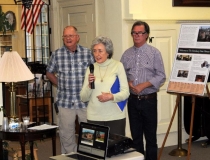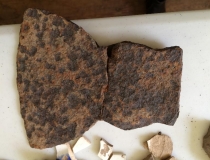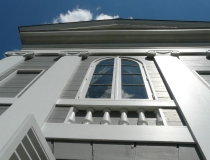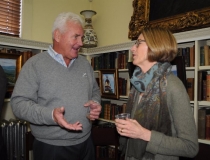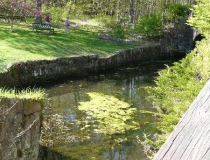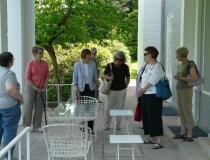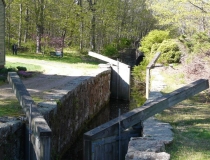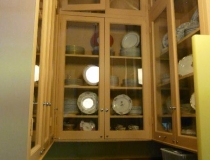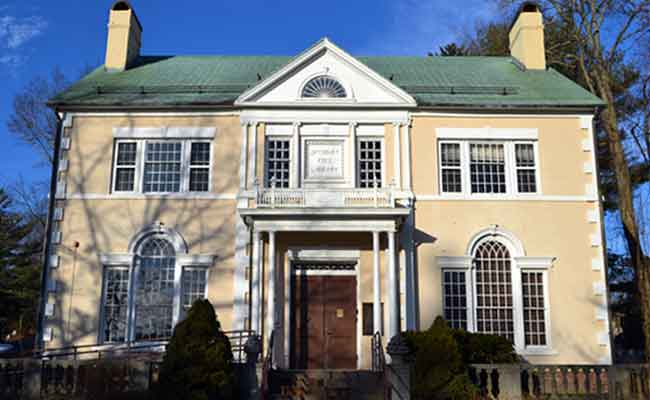The Eno Family and Simsbury
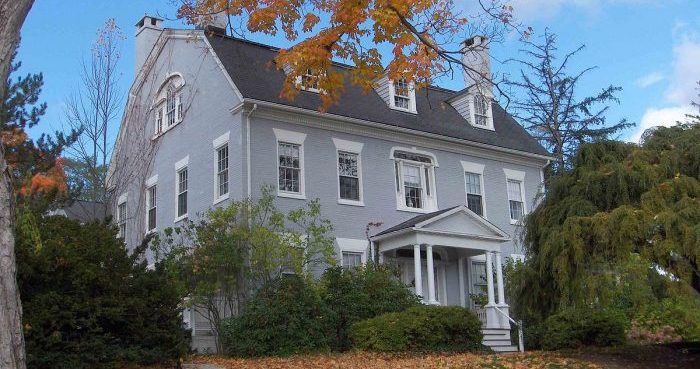
The Eno Family has influenced Simsbury since Colonial days and participated in the great events of the country’s history.
In 1648, just 28 years after the Mayflower arrived at Massachusetts Bay, twenty-three year old James Enno departed London for North America, settling in Windsor. A descendent of French Huguenots who fled to England to avoid religious persecution, Enno sought fortune and freedom in the New World. Two years later, Enno married Anna Bidwell. The couple had three children as Enno acquired and farmed land in Windsor and was active in public life.
The Eno Family’s earliest involvement with Simsbury was in 1669 when James Enno acquired land from Indian tribes in what became Simsbury, in 1670, with its separation from Windsor and incorporation. James died in 1682, leaving a significant estate, much of it to his son, James Eno Jr.
Though still based in Windsor, James Eno Jr. also acquired land in Simsbury beginning in the 1670s. James Jr., like his father, was a farmer and active in community and civic affairs. He fought in King Phillip’s War in 1675 and petitioned for a grant of land in Simsbury in return for his service. James Jr. and his wife, Abigail Bissell, had nine children. When James Junior died in 1714, he left an estate twice the size of his father’s, and divided land holdings among three sons, William, John and David.
David, who was only 12 when his father died, grew up at the Windsor homestead. In 1726, David married Mary Gillett of Simsbury and moved to Simsbury, acquiring a house located where St. Mary’s Church now stands. David died at age 43 in 1745, fighting for Britain in a battle with French military at Cape Breton. He left six children including the second youngest, Jonathan, who was seven at the time of his father’s death.
Though his father died as a loyal British subject fighting France’s efforts to expand its North American holdings, Jonathan came of age in the years leading to the American Revolution. With his older brothers inheriting the family home in Simsbury, Jonathan moved to New Britain (then part of Farmington) where a sister and her family were living. There, he met and married Mary Hart and lived until 1774. In that year, Jonathan and his family returned to Simsbury, purchasing property and a house from John Case located close to today’s intersection of Route 10/202 and Rt. 315. This property remained in the Eno family for almost 200 years.
Jonathan farmed, acquired surrounding property through the years, and operated the home as a tavern as it stood on the Post Road from Boston to Albany. He fought the British in the Revolutionary War, becoming a Captain in the Colonial militia. He was active in town affairs. Jonathan died in 1813, leaving his wife and nine children.
One of Jonathan’s children was Salmon Eno, born in 1779. Salmon lived most of his life in Simsbury and held many public offices in his lifetime: surveyor of highways, assessor, selectman, and, in 1834, a member of the Connecticut Legislature. Salmon and his wife, Mary Richards of New Britain, had six children, including Amos R. Eno. Amos’s life story illustrates the nineteenth century development of America’s mercantile class, the growth of its major cities, especially New York, with industrialization and the fortunes that were to be made through these huge economic transformations.
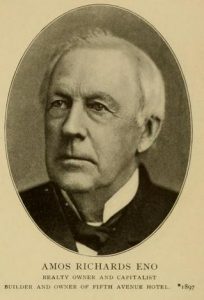 Amos R. Eno was born in Simsbury in 1810 and was a farmer boy until age 16 when he left for Hartford to be a clerk at a dry goods establishment. He returned to Simsbury and opened a store at Hoskins Station and did a thriving business. In 1833, he moved to New York and established a dry goods business called Eno & Phelps with his cousin, John J. Phelps. Eventually, that partnership was dissolved and Eno organized a new firm called Eno, Mahony & Co. that, in addition to the dry goods business, began to acquire and develop real estate in Manhattan. By 1857, the real estate business had grown so large that Eno gave up the dry goods business to focus only on real estate.
Amos R. Eno was born in Simsbury in 1810 and was a farmer boy until age 16 when he left for Hartford to be a clerk at a dry goods establishment. He returned to Simsbury and opened a store at Hoskins Station and did a thriving business. In 1833, he moved to New York and established a dry goods business called Eno & Phelps with his cousin, John J. Phelps. Eventually, that partnership was dissolved and Eno organized a new firm called Eno, Mahony & Co. that, in addition to the dry goods business, began to acquire and develop real estate in Manhattan. By 1857, the real estate business had grown so large that Eno gave up the dry goods business to focus only on real estate.
Amos earned millions in New York real estate, and made the city his home. However, he and his wife, Lucy Phelps, also from Simsbury, continued to return to the town for summers and took great interest in the town’s affairs. Amos established and endowed the Simsbury Free Library in 1874 and gave a farm to the town to house its poor. After Lucy’s father, Elisha Phelps, died, Amos and Lucy purchased the Phelps family home on Hopmeadow Street. That house still exists and is now known as the 1820 House. Amos spent many of his later years as a permanent resident of Simsbury. He died in 1898.
Two of Amos’s children served the Union Army in the American Civil War. Amos F. served as a Colonel while Henry Clay, a physician, served as a medical cadet.
Several of Amos and Lucy’s other nine children also made significant contributions to local and national life.
- Mary Jane (1838–1914) married James Pinchot of Pennsylvania and was mother to Gifford Pinchot, born in Simsbury in 1865, who became the first Chief of the US Forest Service and two-time Pennsylvania Governor. At the turn of the century, Gifford was a leading advocate of the conservation of the nation’s forest resources through planned use and renewal. The Pinchot Sycamore next to the Farmington River on Route 185 in Simsbury is named in Gifford’s honor.
- Antoinette Eno Wood (1842–1930) lived in Simsbury and left the Town of Simsbury funds to construct Eno Memorial Hall as a center for civic activity.
- William Phelps Eno (1858–1945) was concerned with traffic chaos as automobiles began to compete with horses and carriages at the turn of the century. He created what became known as the “Rules of the Road” that brought order to automobile traffic in the early twentieth century. France credits Eno’s traffic rules with their ability to keep their troops at Verdun supplied during World War I. Eno founded the Eno Transportation Foundation which continues to be a leading research and analysis organization today. Many of his person papers and effects are housed at the Simsbury Free Library.
Amos Eno House photo credit: Sphilbrick – Own work, CC BY-SA 3.0, commons.wikipedia.org

